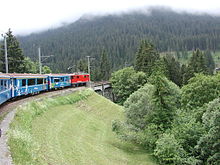Arosa Express
The Arosa-Express was specifically for the tourism -designed express train on the railway line Chur-Arosa of the Rhaetian Railway (RhB) in the canton of Grisons , Switzerland . The train officially existed from 1997 to 2007 and ran several times a day between the canton capital Chur and the holiday resort of Arosa throughout the year .
prehistory
The imminent replacement of the outdated locomotives and economic reasons prompted the RhB in the mid-1980s to consider converting the contact wire voltage of the Arosa Railway to single-phase alternating current . This measure, implemented in 1997 after extensive adaptation work, enabled the Chur – Arosa railway to be included in the so-called main network of the RhB. This enabled a more efficient use of vehicles and considerable savings in the procurement and maintenance of rolling stock. This makeover has meant that the elderly railcars at the end of November 1997 Abe 4/4 and ABDe 4/4 the Schanfigg left and the main line electric locomotives Ge 4/4 II occurred with the numbers 611 to 633 in its place. At the same time, the RhB launched the Arosa Express, a new, specially designed train composition.
description
The aim of the Arosa-Express was to offer travelers between Chur and Arosa a new and contemporary rail experience. Unusual colors and comfortable interior design gave the composition, which was converted from older rolling stock, an attractive appearance. The blue exterior paintwork, which deviated from the usual RhB paint scheme, with a striking alpine flora decor corresponded to the appearance of the sports and holiday resort of Arosa designed by marketing specialists. This design could also be seen as a throwback to the original society's color scheme. The Arosa Bergbahnen , the Arosas tourism organization and the municipality itself were obliged to finance the train composition with contributions totaling around 600,000 Swiss francs . These sponsors also played a key role in the international marketing of the new train. The maiden voyage of the Arosa Express took place on November 29, 1997, immediately after the contact wire voltage had been changed, with a journey from Chur to Arosa. The train did not require a reservation or a supplement. As a rule, the connections with the Arosa Express departing shortly after 10:00 a.m. from Chur and the connections departing from Arosa shortly before 3:00 p.m. were occupied. In addition, the composition was also used at other times of the day as required.
Rolling stock used
The conversion necessary for the installation of the composition was made from five existing cars. These included a control car (Bt 1703), a second class car (B 2319), a mixed-class car (AB 1570), a first class car with large panoramic windows (As 1256) and a combined bar and luggage car , originally with a smoking compartment ( BD 2481). Another second class car was prepared for summer traffic (B 2315). The Arosa Express operated as a shuttle train . The electric locomotive was coupled on the mountain side.
Design of the vehicles

In addition to modern passenger coaches with first and second class compartments, the saloon coach in particular attracted the public. By merging earlier window openings, two large panoramic windows were created. In this area, the view of the landscape has also been improved by means of semicircular upholstered groups with small tables. The control car contained a special club compartment as a meeting point. Furthermore, a separate part of the baggage car was made available to travelers as a temporary catering facility. Housed here stand-up bar and some seating also served as a smoking lounge in the otherwise non-smoking train. During the trip, the travelers were given information about the railway line and the Schanfigg over loudspeakers in various languages.
Todays situation

The agreement between the service providers for the operation of the Arosa Express was set for ten years. Despite the success of the train, a contract extension in the previous framework was waived after the end of the operating time. The planned introduction of the most modern multiple unit train sets of the type ABe 8/12 combined with their greater flexibility in the train composition made a continuation of the concept appear too expensive. The Arosa-Express no longer exists as a brand. Individual blue vehicles can also be found on other RhB lines, the other part has already been painted red again. Only the enlarged panorama windows of the As 1256 will still be reminiscent of the Arosa Express.
literature
- Ueli Haldimann , Tibert Keller, Georg Jäger : Experience Chur-Arosa-Bahn - Foray through the Schanfigg , AS Verlag & Buchkonzept AG, Zurich 2014, ISBN 978-3-906055-25-1 , p. 112.
- Hans Danuser : Arosa - as it was back then. Volume 7: 1996-2003 . Self-published by Danuser, Arosa 2004, pp. 31, 42.
- Beat Moser / Peter Pfeiffer: The RhB. Part 3: St. Moritz – Samedan – Zernez – Scuol-Tarasp, Pontresina – Samedan and Chur – Arosa . Hermann-Merker-Verlag, Fürstenfeldbruck 1998 (Eisenbahn-Journal, Special 1998/4), ISBN 3-89610-038-6 (2nd edition 2005: ISBN 978-3-89610-150-1 ), pp. 66-69 .
- Hans-Bernhard Schönborn: The Rhaetian Railway. History and present. GeraMond, Munich 2009, ISBN 978-3-7654-7162-9 , pp. 115, 124 f.
Individual evidence
Web links
Coordinates: 46 ° 47 '2.6 " N , 9 ° 40' 45.3" E ; CH1903: 771 077 / 183873


